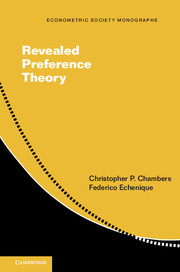Book contents
- Frontmatter
- Dedication
- Contents
- Preface
- 1 Mathematical Preliminaries
- 2 Classical Abstract Choice Theory
- 3 Rational Demand
- 4 Topics in Rational Demand
- 5 Practical Issues in Revealed Preference Analysis
- 6 Production
- 7 Stochastic Choice
- 8 Choice Under Uncertainty
- 9 General Equilibrium Theory
- 10 Game Theory
- 11 Social Choice and Political Science
- 12 Revealed Preference and Systems of Polynomial Inequalities
- 13 Revealed Preference and Model Theory
- References
- Index
- Miscellaneous Endmatter
1 - Mathematical Preliminaries
Published online by Cambridge University Press: 05 January 2016
- Frontmatter
- Dedication
- Contents
- Preface
- 1 Mathematical Preliminaries
- 2 Classical Abstract Choice Theory
- 3 Rational Demand
- 4 Topics in Rational Demand
- 5 Practical Issues in Revealed Preference Analysis
- 6 Production
- 7 Stochastic Choice
- 8 Choice Under Uncertainty
- 9 General Equilibrium Theory
- 10 Game Theory
- 11 Social Choice and Political Science
- 12 Revealed Preference and Systems of Polynomial Inequalities
- 13 Revealed Preference and Model Theory
- References
- Index
- Miscellaneous Endmatter
Summary
We begin by reviewing basic mathematical facts and notation that we shall use repeatedly in the book. The basic results we need relate to binary relations and their extensions and representations, and to solutions to systems of inequalities.
BASIC DEFINITIONS AND NOTATIONAL CONVENTIONS
Relations
Let X be a set. An n-ary relation on X is a subset of Xn. A binary relation on X is a subset of X ×X. When R is a binary relation on X, we write (x, y) ∈ R as x R y. When R is an n-ary relation, we also write R(x1, …, xn) instead of (x1, …, xn) ∈ R.
Given a binary relation R, define its strict part, or asymmetric part, PR by (x, y) ∈ PR iff (x, y) ∈ R and (y, x) ∉ R. Define its symmetric part, or indifference relation, IR by (x, y) ∈ IR iff (x, y) ∈ R and (y, x) ∈ R. Two elements x, y ∈ X are unordered by R if (x, y) ∈ R and (y,x) ∈ R.
Two elements are ordered by R when they are not unordered by R. We say that a binary relation B is an extension of R if R ⊆ B and PR ⊆ PB. A binary relation B is a strict extension of R if it is an extension, and in addition there is a pair that is unordered by R but ordered by B. Finally, a binary relation is complete if it leaves no pair of elements unordered. That is, R is complete if for all x and y, x R y or y R x (or both).
The following are standard properties of binary relations. A binary relation R is:
• transitive if, for all x, y, and z, x R y and y R z imply that x R z;
• quasitransitive if, for all x, y, and z, xPR y and yPR z imply that xPR z;
• reflexive if x R x for all x;
• irreflexive if (x, x) ∉ R for all x;
• symmetric if, for all x and y, (x, y) ∈ R implies that (y, x) ∈ R;
- Type
- Chapter
- Information
- Revealed Preference Theory , pp. 1 - 14Publisher: Cambridge University PressPrint publication year: 2016



